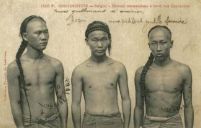Growing into the queue
This is a Qing style queue. Cut off from its bearer, the queue begins with braided real human hair. About a foot in, a twined, red silken thread starts to mix in with the hair. Yet another foot down the queue, the real hair stops, working towards a rich, red tassel. This is one of the three queues in a private collection of over 600 objects that was purchased by the Nationaal Museum Voor Wereldculturen in 1899 [RV-1239*]. 132 objects in this lot connect to the Qing empire, as does this queue. The bearers of this type of Qing queue were all men. We do not know what age this man was when he had his queue cut off, nor do we have any details about his heritage. What we know is that this is a Qing style queue, and a rather colorful specimen thereof.
Qing queues went through phases of being hated and loved; of being grown, shown and hid, and of being cut and collected. At the end of this story we will follow this queue back to the collection where it is now enjoying its afterlife, but let us first try to imagine this queue’s life when it was still attached to an owner who, as we can see, cared deeply for his queue.
At the end of the 16th century, from a small area just outside of Korea, the Manchus started to build an empire that grew into one of the biggest land empires in history: the Qing empire (1636-1912). We know that at least from 1621, the male population of the peoples that fell victim to the Manchu enterprise were forced to show their loyalty by taking over the distinctive Manchu coiffure: a shaven forehead and a long braided queue. The origins of this hairstyle have been linked to the worshipping of horses, the most crucial companion in the life of the people from the steppes [cf]. Others connect it to its practicality in keeping a clear vision during the hunt. Besides, the goal of this uniform style may also have been to take away the ability of hair to reflect individual aesthetic preferences and social differences.[cf] This family of queues has a long history that has been traced back to a tribal confederation that inhabited the eastern Eurasian Steppe from the 3rd century BC to the late 1st century AD [cf]. The Manchus, however, were the first people to successfully enforce it upon peoples beyond the steppes, on the other side of the Great Wall. Before the Manchus conquered China, the enforcing of their own hairstyle was standard policy in the campaigns to the Northeast of the Great Wall. When the Manchus took over the rule of the Chinese Ming court, this requirement was suspended, but not for long: in the summer of 1645the 24 year old Han Chinese Yao Wenxi writes in his Daily Jottings from the end of the Ming:
When the Qing came into the city, everyone said that only military officers and soldiers needed to shave their heads … After a few days an edict was issued notifying … that every male was to shave his head within three days and cultivate a coin-sized rat’s tail. Anyone who didn’t conform was to be killed. The common people were afraid to die, so within three days the men had shaved their heads shiny clean … We young men cherished our hair and when we saw people with shaven heads, they didn’t seem human. At first some of us hid out, unwilling to shave; but later we didn’t see anyone on the streets unshaven. We had to shave.[cf, p 64]
This new hairstyle was a major change for the Han Chinese men, who were used to having a small bun on top of their head, their skull unshaven. Though initially met with heavy resistance in the 17th century, the Manchu braid became part of everyday life in China under the Manchus. The men grew into their queue. They had them dangle at the back and in the front, wrapped them around their head and covered them up when convenient. James Dyer Ball, who lived in China for almost his whole life, describes his view on the queue around 1905:
Thus suspended down the back the queue is apt to be in the way when the wearer is at work. It is then rolled into a knot on the back of the head or neck, or loosely coiled round the head or shoulders, and thus it is out of the way. This is the equivalent of our Western condition of being in one’s shirt-sleeves, and the workman or servant hastens to uncoil and let the queue down when coming into the presence of his superior or master. When the owner is putting on his outer robe the queue has, of course, to be pulled out, as it lies down the back of the inner garment. The cyclist brings the end of his queue round from his back, and tucks it into his breast pocket or the top of his leggings, to prevent it being entangled in his back wheel. If the queue be caught in machinery, the poor Chinaman may be scalped. One of the most comical sights the author has ever seen was a row of Chinese sitting in a hill tramcar in Hong Kong. As the tram went up the hill at a steep slope of one foot in two, all the queues hung out behind the wearers at an angle of 45 degrees [cf]

